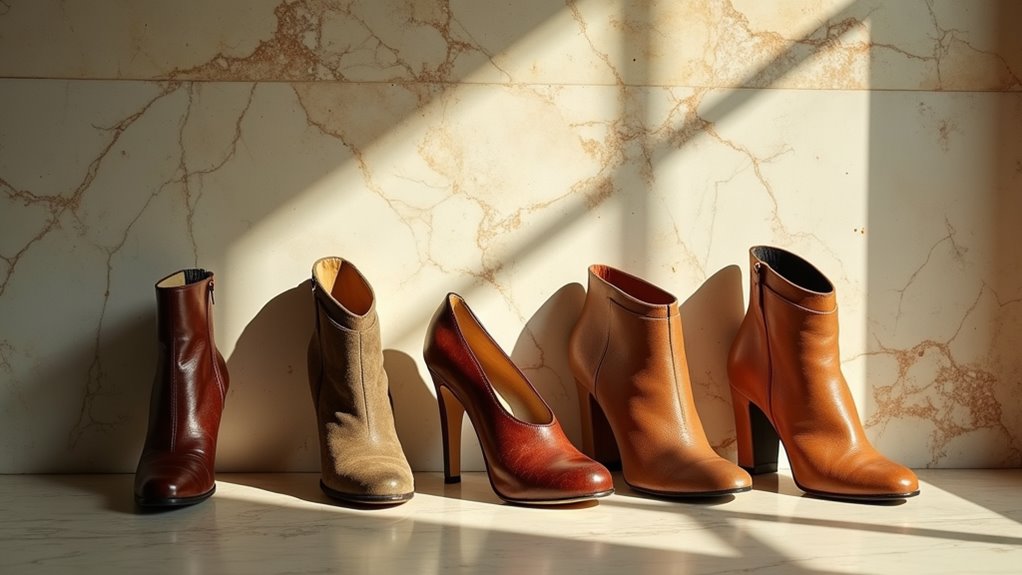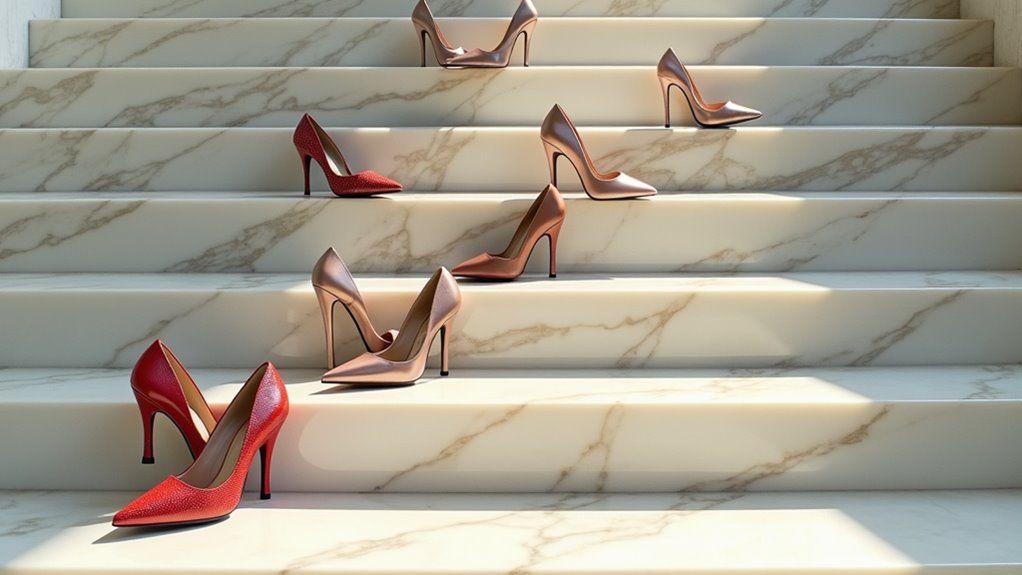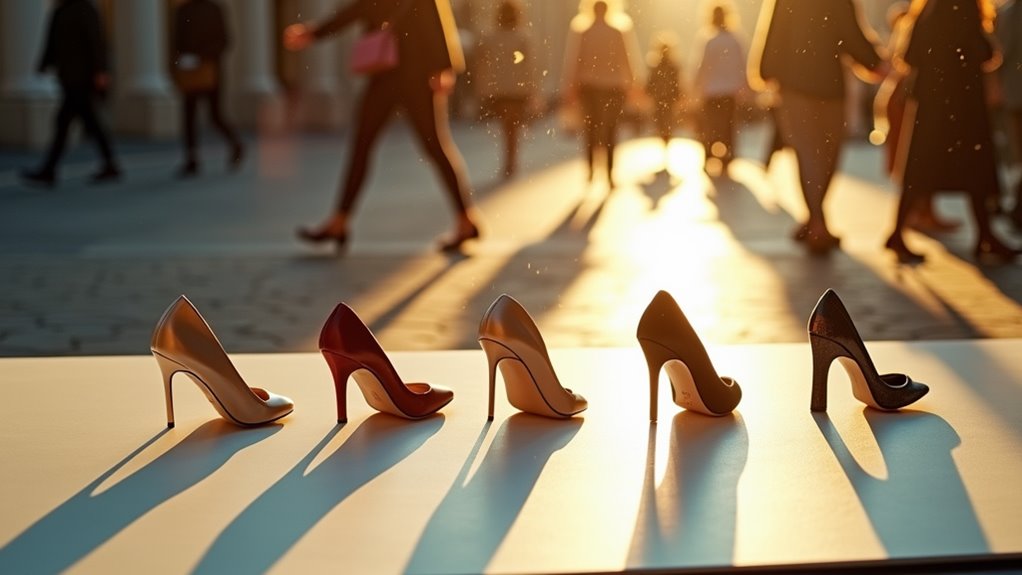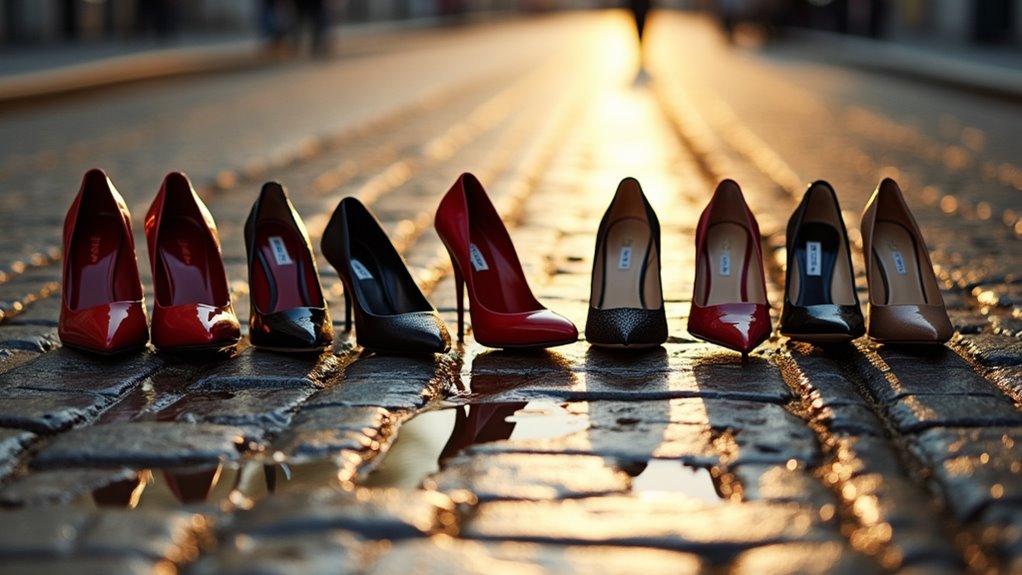There may be products. Products are independently selected by our editors. We may earn an affiliate commission from the links with no charge to you, example: as Amazon Affiliate.
We’ve witnessed heels transform from Persian warriors’ symbols of power to modern fashion statements, revealing fascinating insights about society’s views on gender and status. Today’s women are challenging traditional expectations, with many choosing comfort over conventional beauty standards. We’re seeing a cultural shift as workplaces embrace flats and sustainable footwear, while marketing still heavily promotes high heels as symbols of success. Health awareness has sparked conversations about the real cost of fashion, and the anti-high-heel movement continues gaining momentum. The evolution of heels tells a deeper story about women’s changing roles in society.
Key Takeaways
- Modern workplaces increasingly reject mandatory heel requirements, prioritizing comfort and employee well-being over traditional dress codes.
- High heels’ historical evolution from male power symbols to feminine fashion reveals their cultural significance is socially constructed.
- Marketing tactics often manipulate women’s choices by linking high heels to success and luxury, despite health risks.
- The rise of comfortable footwear trends challenges traditional beauty standards and redefines modern elegance.
- Sustainable and health-conscious shoe alternatives offer women stylish options without sacrificing physical comfort or environmental responsibility.
The Historical Power of Heels

Throughout history, high heels have transcended their humble origins as practical riding footwear to become powerful symbols of status, gender, and social influence. We find their fascinating journey beginning in 10th century Persia, where men wore heels as a symbol of masculinity and power, particularly while riding horses.
What’s remarkable is how high heels shifted from men’s fashion to become deeply intertwined with women’s societal norms. By the time they reached European courts in the 16th century, these elevated shoes had already begun their transformation into status symbols. At the French court of Louis XIV, heels became the ultimate mark of privilege and aristocracy, setting standards that would influence fashion for centuries to come.
The evolution of high heels reaches a pivotal moment in the 1950s, when stilettos emerged as the quintessential symbol of femininity. Today, we’re witnessing an ongoing dialogue about their role in women’s empowerment and identity. Like the necktie for men, high heels have become deeply embedded in our cultural understanding of gender expression, prompting important conversations about choice, power, and self-determination in modern society. The timeless elegance of 1950s style heels continues to influence modern fashion, offering women classic sophistication in contemporary footwear designs.
Health Impacts and Personal Choices
Beyond their cultural significance, high heels present a complex intersection of fashion and physical well-being that modern society can no longer ignore. We’re witnessing a significant shift as women wearing traditional high heels face mounting evidence of serious health impacts, from chronic foot pain to lasting deformities, particularly with heels exceeding three inches.
Let’s examine the emerging revolution in womens dress shoes, where comfort meets style. More professional women are choosing practical low-mid heels for their corporate environments, recognizing that career success shouldn’t require physical sacrifice. This shift isn’t just about comfort – it’s about acknowledging the real risks associated with prolonged heel use, including compromised mobility and increased injury potential.
We’re seeing a transformative moment where comfortable shoes are becoming increasingly accepted in professional settings. Research consistently shows that prioritizing foot health through sensible footwear choices leads to improved overall well-being. The modern woman’s wardrobe is evolving to reflect this understanding, proving that we can maintain sophistication while protecting our physical health. This isn’t about abandoning style – it’s about redefining it with our well-being in mind. Today’s conscientious consumers can choose from an expanding selection of sustainable heels that combine eco-friendly manufacturing with healthier design features.
Marketing’s Influence on Women

Modern marketing’s grip on women’s footwear choices reveals a calculated manipulation of desire and identity. We’re bombarded daily with carefully curated displays where high-heeled shoes dominate 85% of retail spaces, leaving minimal room for practical alternatives. This isn’t coincidental – it’s a deliberate strategy to shape consumer perceptions and purchasing habits.
Marketing strategies have masterfully transformed heels into symbols of luxury and success. We’re constantly exposed to advertising that connects wearing high heels with an aspirational lifestyle, making us believe these shoes are essential for projecting sophistication and professional achievement. The luxury image carefully crafted around women’s shoes plays into our deeper desires for status and social acceptance.
What’s particularly striking is how these campaigns have normalized discomfort in the name of fashion. We’ve been conditioned to prioritize style over practicality, often making impulse purchases based on emotional triggers rather than rational decision-making. The way high heels are marketed isn’t just about selling shoes – it’s about selling an identity, a promise of elevated social status that’s cleverly designed to override our practical concerns about comfort and functionality. Fortunately, the rising trend of sustainable non-leather heels offers fashion-conscious consumers an ethical alternative without compromising style or social status.
Modern Fashion Culture Shifts
Shifting attitudes in fashion culture have sparked a remarkable rebellion against traditional footwear norms. We’re witnessing a seismic transformation in women’s shoes, as comfortable footwear like Birkenstocks and Crocs challenges the long-standing reign of high heels.
Despite retail displays still being dominated by impractical heels, we’re experiencing a powerful shift in consumer preferences. The anti-high-heel movement, energized by social justice initiatives like #MeToo and Time’s Up, has become a symbol of resistance against outdated societal expectations. Modern fashion culture increasingly celebrates comfort as a form of empowerment, breaking free from the constraining notion that elegance requires discomfort.
This evolution reflects deeper changes in our values. While high heels once symbolized sophistication and desirability, today’s younger generations are redefining style through the lens of practicality and self-expression. We’re seeing brands respond to this cultural shift by innovating comfortable yet fashionable alternatives. The declining popularity of moderate heels signals more than just a trend – it represents a fundamental reimagining of what it means to be stylish in contemporary society. Those seeking fashionable footwear are increasingly turning to sustainable heel options that align with both environmental consciousness and modern comfort demands.
Society’s Evolving Heel Perspectives

Today’s society increasingly questions the cultural grip of high heels, marking a profound shift in our collective understanding of fashion and empowerment. We’re witnessing a remarkable transformation in workplace norms, where comfortable footwear is gaining precedence over traditional expectations. The fact that high heels dominate 85% of women’s shoe displays no longer aligns with modern preferences. More women are choosing sustainable heel materials that minimize environmental impact while maintaining style.
| Era | Attitude | Impact |
|---|---|---|
| Past | Heels = Power | Limited choices |
| Present | Comfort First | Diverse options |
| Future | Personal Choice | Cultural freedom |
The rise of flat shoes and “ugly fashion” signals more than just a trend – it’s a cultural revolution. We’re seeing power dynamics shift as movements like #MeToo challenge conventional dress codes. Cultural trends now favor individual comfort over societal pressure, transforming how we view professional attire. Legal precedents, like British Parliament’s stance against mandatory heel heights, reflect our evolving perspectives on workplace attire. As we continue to redefine beauty standards, the disproportionate presence of high heels in retail displays increasingly contrasts with real-world preferences for comfort-focused footwear.
Conclusion
We’ve witnessed a remarkable shift in heel culture, with studies showing that high heel sales dropped 71% during 2020 – a dramatic change reflecting deeper social transformations. While heels once symbolized status and power for both men and women, today’s choices are more about personal expression than societal pressure. As we move forward, let’s celebrate this freedom to choose comfort, style, or both – whatever best fits our individual paths.

